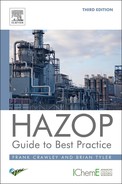Company Procedures for HAZOP Study
Consideration of the need and benefits from having a dedicated procedure for HAZOP study within a company. A list is given of the items that should be covered within a procedure to ensure that the essential elements of the method are included as well as any special aspects that are specific to the company.
Keywords
HAZOP procedure; essentials for HAZOP; company-specific aspects
If HAZOP studies are regularly used as part of a company’s process hazard studies, a company procedure on the execution of a HAZOP study is recommended. This helps greatly in the uniformity of application and maintenance of standards and simplifies the reporting of any study carried out in accordance with the procedure. All of the relevant issues described in Chapters 2–8 of this guide can be included, as can those covered in the IEC guide.7 It is important to give advice on the selection of suitable techniques for process hazard studies so that a HAZOP study is considered whenever it might be appropriate and is used when it is best suited.
A company procedure might cover:
• responsibility for initiating a study;
• where HAZOP might be applied and how it relates to other Hazard Studies;
• the purpose and the range and depth of study;
• any special requirements, for example, checking cause and effect diagrams;
• timing of the study, within the overall project and the detailed meetings;
• terms of reference and scope;
• detailed HAZOP methodology to be used;
• follow-up and implementation of actions;
• how records will be maintained;
• how the study integrates with the company’s MOC procedure.
Further important aspects to be considered are:
• appointing a leader and scribe;
• team selection, composition, and training;
• documentation needed for the study;
• facilities for the team meetings;
• style and level of recording and the recording format;
• application (or not) of risk assessment with, if necessary, a suitable (corporate) risk matrix;
The HAZOP methodology could be expected to cover:
• approaches to continuous and batch processes;
• consequence types (hazards, operability, financial, quality, reputation, etc.);
• consideration of safeguards;
A company procedure must cover the general, basic HAZOP methodology, as indicated above, but it should also be tailored to the particular activities and types of process and materials used, as well as to the specific company arrangements for administration and organization. The standard guidewords should always be considered but there may be additional ones that have proved useful in previous studies. Likewise a list of parameters can be produced to act as a minimum set to be considered during a study. This can be particularly useful with the guideword “other/other than.” There can be a list of specific issues that must be addressed, for example, in drilling where the clays can become agglomerated and then may choke the mud gutters. Another possible special issue is how shutdowns are addressed—there may be multiple levels of shutdown from the process shutdown (or “hold”) to the ultimate shutdown for a major incident.
